Business and Business Environment Analysis Report (Coca-Cola)
VerifiedAdded on 2020/07/22
|18
|5045
|76
Report
AI Summary
This report provides a comprehensive analysis of the business and its environment, covering various aspects of organizational structures, including public, private, and voluntary sectors. It begins by defining organizations and their purposes, then delves into the size and scope of different organizational types. The report uses Coca-Cola as a case study, examining its functions, interrelations, objectives, and organizational structure. It identifies and discusses the macro and micro environmental factors impacting Coca-Cola, including a SWOT analysis of Coca-Cola and PepsiCo. The report concludes by explaining how micro environmental factors interrelate with the external macro factors, offering a detailed understanding of the business environment and its influences on a major company like Coca-Cola.
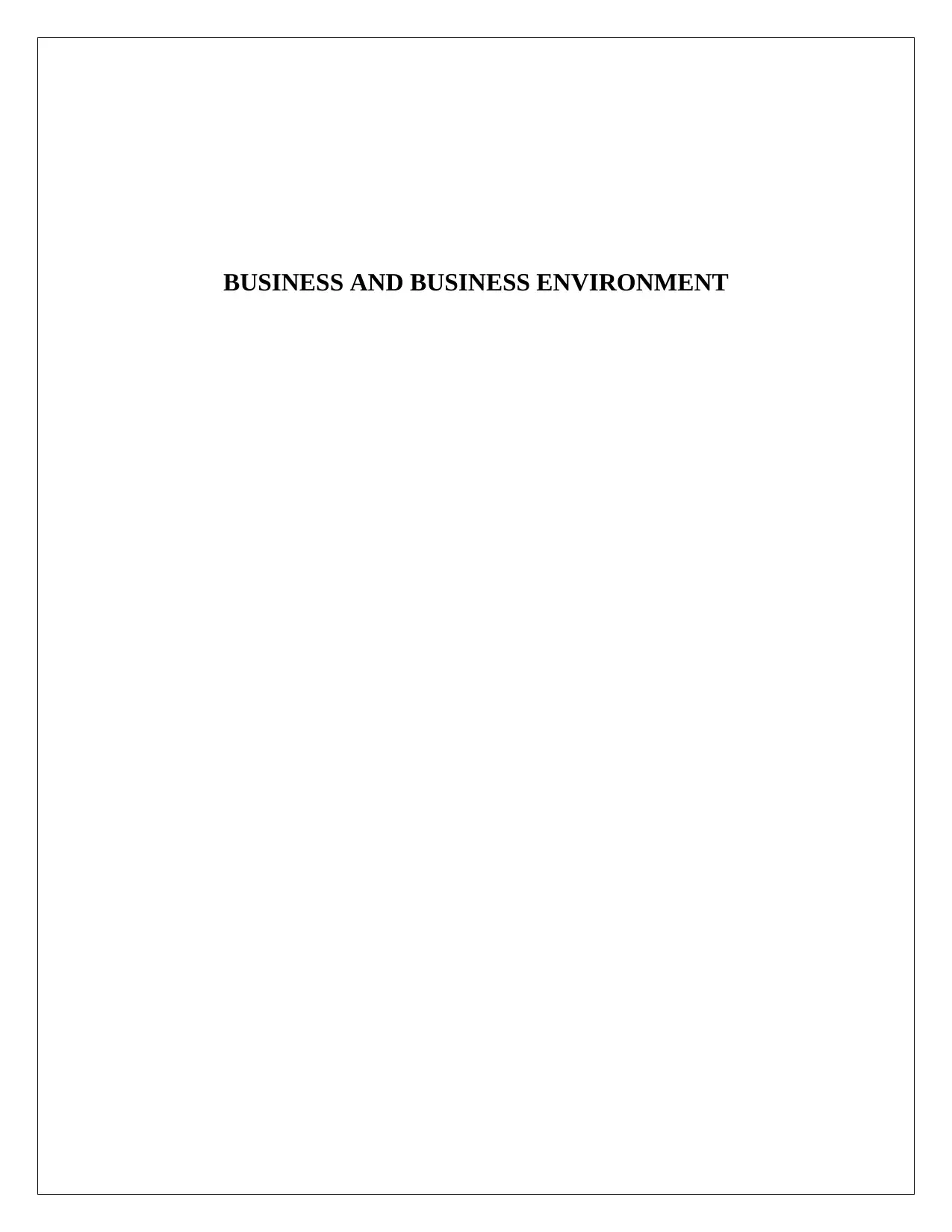
BUSINESS AND BUSINESS ENVIRONMENT
Paraphrase This Document
Need a fresh take? Get an instant paraphrase of this document with our AI Paraphraser
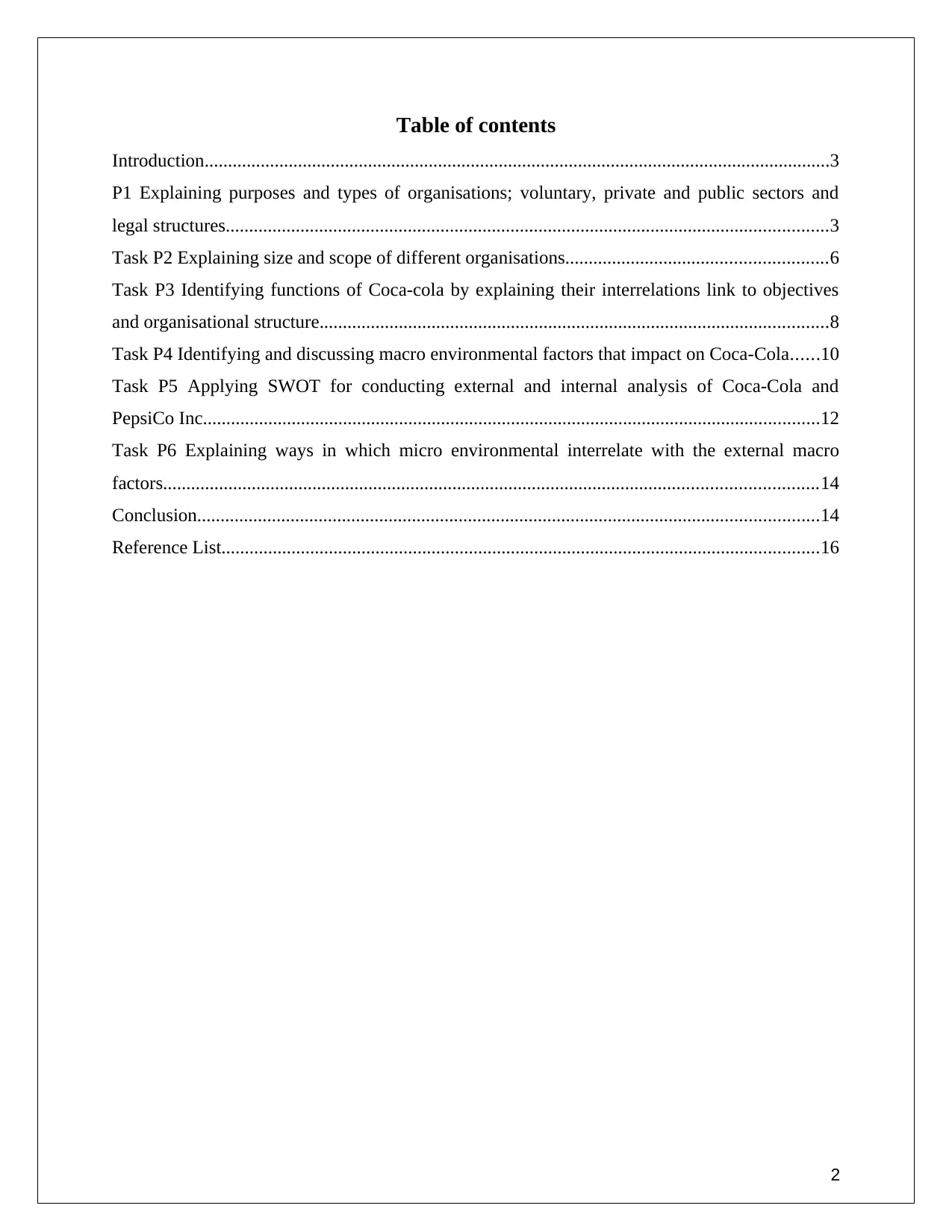
Table of contents
Introduction......................................................................................................................................3
P1 Explaining purposes and types of organisations; voluntary, private and public sectors and
legal structures.................................................................................................................................3
Task P2 Explaining size and scope of different organisations........................................................6
Task P3 Identifying functions of Coca-cola by explaining their interrelations link to objectives
and organisational structure.............................................................................................................8
Task P4 Identifying and discussing macro environmental factors that impact on Coca-Cola......10
Task P5 Applying SWOT for conducting external and internal analysis of Coca-Cola and
PepsiCo Inc....................................................................................................................................12
Task P6 Explaining ways in which micro environmental interrelate with the external macro
factors............................................................................................................................................14
Conclusion.....................................................................................................................................14
Reference List................................................................................................................................16
2
Introduction......................................................................................................................................3
P1 Explaining purposes and types of organisations; voluntary, private and public sectors and
legal structures.................................................................................................................................3
Task P2 Explaining size and scope of different organisations........................................................6
Task P3 Identifying functions of Coca-cola by explaining their interrelations link to objectives
and organisational structure.............................................................................................................8
Task P4 Identifying and discussing macro environmental factors that impact on Coca-Cola......10
Task P5 Applying SWOT for conducting external and internal analysis of Coca-Cola and
PepsiCo Inc....................................................................................................................................12
Task P6 Explaining ways in which micro environmental interrelate with the external macro
factors............................................................................................................................................14
Conclusion.....................................................................................................................................14
Reference List................................................................................................................................16
2
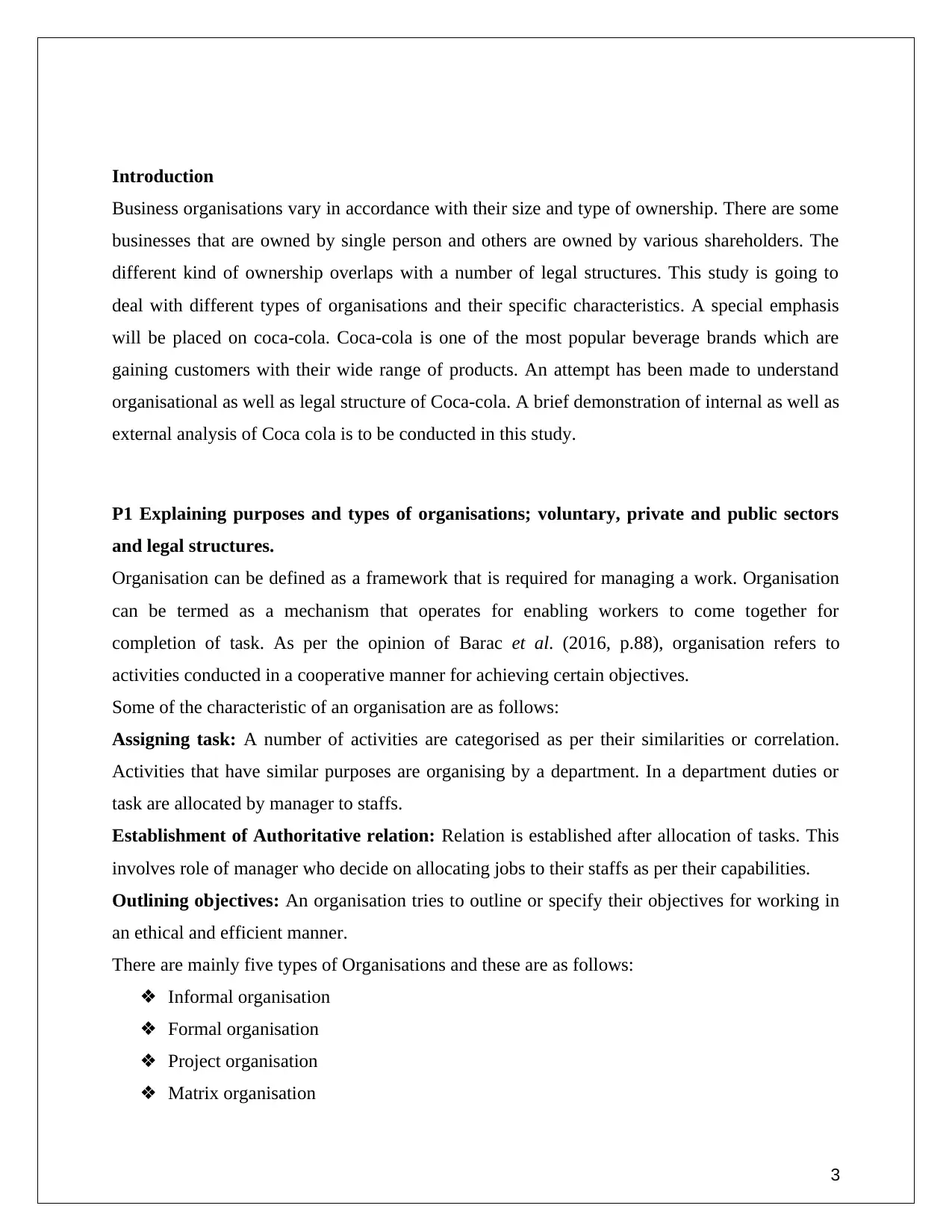
Introduction
Business organisations vary in accordance with their size and type of ownership. There are some
businesses that are owned by single person and others are owned by various shareholders. The
different kind of ownership overlaps with a number of legal structures. This study is going to
deal with different types of organisations and their specific characteristics. A special emphasis
will be placed on coca-cola. Coca-cola is one of the most popular beverage brands which are
gaining customers with their wide range of products. An attempt has been made to understand
organisational as well as legal structure of Coca-cola. A brief demonstration of internal as well as
external analysis of Coca cola is to be conducted in this study.
P1 Explaining purposes and types of organisations; voluntary, private and public sectors
and legal structures.
Organisation can be defined as a framework that is required for managing a work. Organisation
can be termed as a mechanism that operates for enabling workers to come together for
completion of task. As per the opinion of Barac et al. (2016, p.88), organisation refers to
activities conducted in a cooperative manner for achieving certain objectives.
Some of the characteristic of an organisation are as follows:
Assigning task: A number of activities are categorised as per their similarities or correlation.
Activities that have similar purposes are organising by a department. In a department duties or
task are allocated by manager to staffs.
Establishment of Authoritative relation: Relation is established after allocation of tasks. This
involves role of manager who decide on allocating jobs to their staffs as per their capabilities.
Outlining objectives: An organisation tries to outline or specify their objectives for working in
an ethical and efficient manner.
There are mainly five types of Organisations and these are as follows:
❖ Informal organisation
❖ Formal organisation
❖ Project organisation
❖ Matrix organisation
3
Business organisations vary in accordance with their size and type of ownership. There are some
businesses that are owned by single person and others are owned by various shareholders. The
different kind of ownership overlaps with a number of legal structures. This study is going to
deal with different types of organisations and their specific characteristics. A special emphasis
will be placed on coca-cola. Coca-cola is one of the most popular beverage brands which are
gaining customers with their wide range of products. An attempt has been made to understand
organisational as well as legal structure of Coca-cola. A brief demonstration of internal as well as
external analysis of Coca cola is to be conducted in this study.
P1 Explaining purposes and types of organisations; voluntary, private and public sectors
and legal structures.
Organisation can be defined as a framework that is required for managing a work. Organisation
can be termed as a mechanism that operates for enabling workers to come together for
completion of task. As per the opinion of Barac et al. (2016, p.88), organisation refers to
activities conducted in a cooperative manner for achieving certain objectives.
Some of the characteristic of an organisation are as follows:
Assigning task: A number of activities are categorised as per their similarities or correlation.
Activities that have similar purposes are organising by a department. In a department duties or
task are allocated by manager to staffs.
Establishment of Authoritative relation: Relation is established after allocation of tasks. This
involves role of manager who decide on allocating jobs to their staffs as per their capabilities.
Outlining objectives: An organisation tries to outline or specify their objectives for working in
an ethical and efficient manner.
There are mainly five types of Organisations and these are as follows:
❖ Informal organisation
❖ Formal organisation
❖ Project organisation
❖ Matrix organisation
3
⊘ This is a preview!⊘
Do you want full access?
Subscribe today to unlock all pages.

Trusted by 1+ million students worldwide
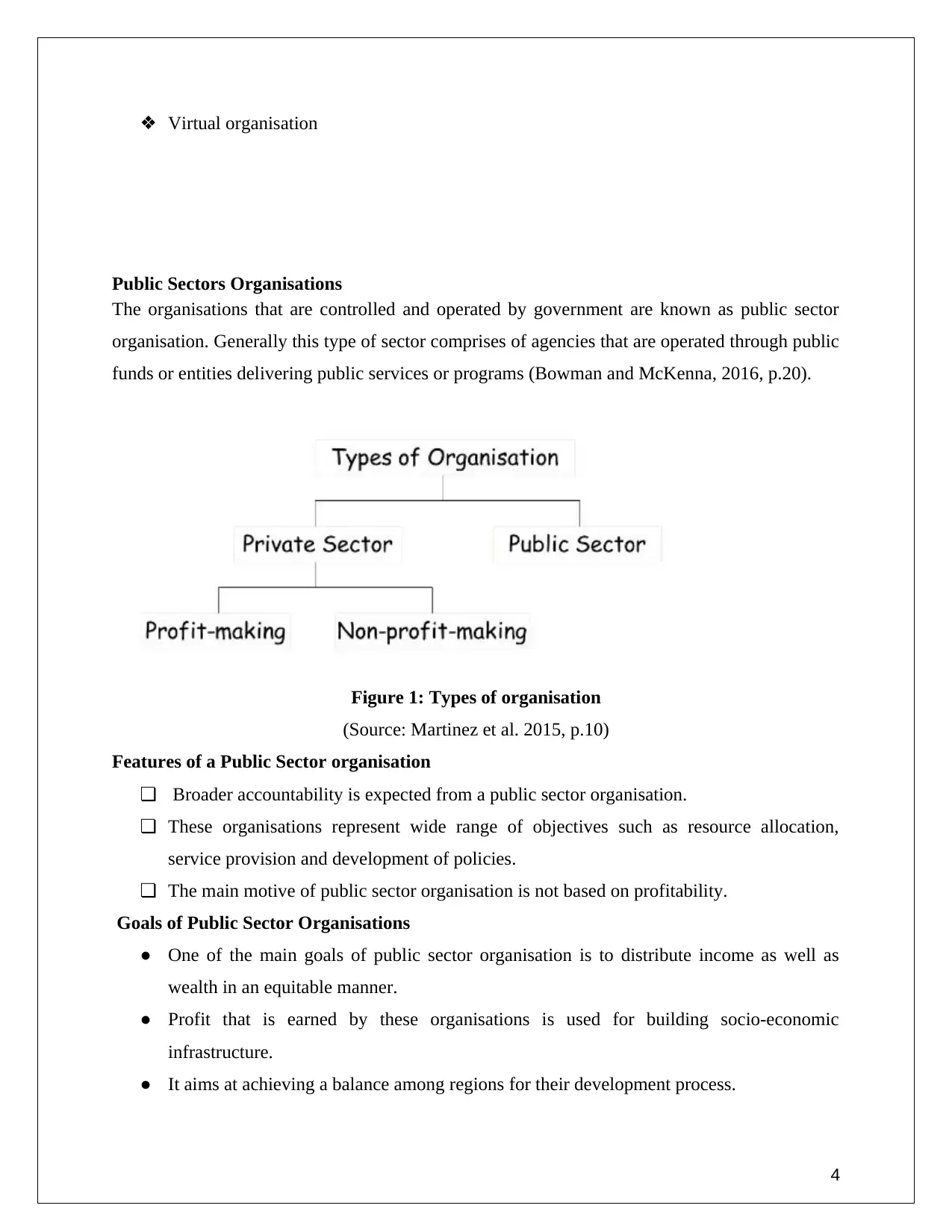
❖ Virtual organisation
Public Sectors Organisations
The organisations that are controlled and operated by government are known as public sector
organisation. Generally this type of sector comprises of agencies that are operated through public
funds or entities delivering public services or programs (Bowman and McKenna, 2016, p.20).
Figure 1: Types of organisation
(Source: Martinez et al. 2015, p.10)
Features of a Public Sector organisation
❏ Broader accountability is expected from a public sector organisation.
❏ These organisations represent wide range of objectives such as resource allocation,
service provision and development of policies.
❏ The main motive of public sector organisation is not based on profitability.
Goals of Public Sector Organisations
● One of the main goals of public sector organisation is to distribute income as well as
wealth in an equitable manner.
● Profit that is earned by these organisations is used for building socio-economic
infrastructure.
● It aims at achieving a balance among regions for their development process.
4
Public Sectors Organisations
The organisations that are controlled and operated by government are known as public sector
organisation. Generally this type of sector comprises of agencies that are operated through public
funds or entities delivering public services or programs (Bowman and McKenna, 2016, p.20).
Figure 1: Types of organisation
(Source: Martinez et al. 2015, p.10)
Features of a Public Sector organisation
❏ Broader accountability is expected from a public sector organisation.
❏ These organisations represent wide range of objectives such as resource allocation,
service provision and development of policies.
❏ The main motive of public sector organisation is not based on profitability.
Goals of Public Sector Organisations
● One of the main goals of public sector organisation is to distribute income as well as
wealth in an equitable manner.
● Profit that is earned by these organisations is used for building socio-economic
infrastructure.
● It aims at achieving a balance among regions for their development process.
4
Paraphrase This Document
Need a fresh take? Get an instant paraphrase of this document with our AI Paraphraser
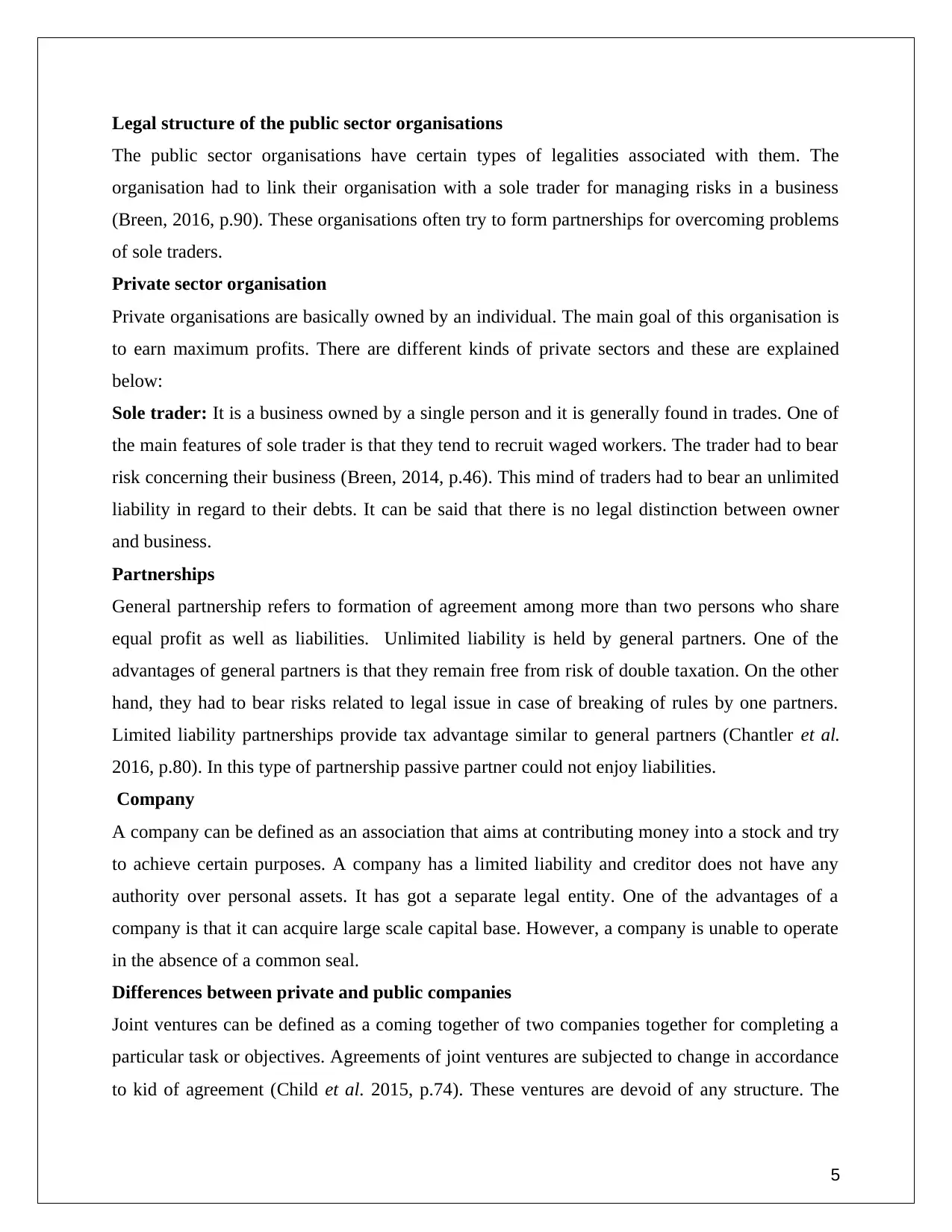
Legal structure of the public sector organisations
The public sector organisations have certain types of legalities associated with them. The
organisation had to link their organisation with a sole trader for managing risks in a business
(Breen, 2016, p.90). These organisations often try to form partnerships for overcoming problems
of sole traders.
Private sector organisation
Private organisations are basically owned by an individual. The main goal of this organisation is
to earn maximum profits. There are different kinds of private sectors and these are explained
below:
Sole trader: It is a business owned by a single person and it is generally found in trades. One of
the main features of sole trader is that they tend to recruit waged workers. The trader had to bear
risk concerning their business (Breen, 2014, p.46). This mind of traders had to bear an unlimited
liability in regard to their debts. It can be said that there is no legal distinction between owner
and business.
Partnerships
General partnership refers to formation of agreement among more than two persons who share
equal profit as well as liabilities. Unlimited liability is held by general partners. One of the
advantages of general partners is that they remain free from risk of double taxation. On the other
hand, they had to bear risks related to legal issue in case of breaking of rules by one partners.
Limited liability partnerships provide tax advantage similar to general partners (Chantler et al.
2016, p.80). In this type of partnership passive partner could not enjoy liabilities.
Company
A company can be defined as an association that aims at contributing money into a stock and try
to achieve certain purposes. A company has a limited liability and creditor does not have any
authority over personal assets. It has got a separate legal entity. One of the advantages of a
company is that it can acquire large scale capital base. However, a company is unable to operate
in the absence of a common seal.
Differences between private and public companies
Joint ventures can be defined as a coming together of two companies together for completing a
particular task or objectives. Agreements of joint ventures are subjected to change in accordance
to kid of agreement (Child et al. 2015, p.74). These ventures are devoid of any structure. The
5
The public sector organisations have certain types of legalities associated with them. The
organisation had to link their organisation with a sole trader for managing risks in a business
(Breen, 2016, p.90). These organisations often try to form partnerships for overcoming problems
of sole traders.
Private sector organisation
Private organisations are basically owned by an individual. The main goal of this organisation is
to earn maximum profits. There are different kinds of private sectors and these are explained
below:
Sole trader: It is a business owned by a single person and it is generally found in trades. One of
the main features of sole trader is that they tend to recruit waged workers. The trader had to bear
risk concerning their business (Breen, 2014, p.46). This mind of traders had to bear an unlimited
liability in regard to their debts. It can be said that there is no legal distinction between owner
and business.
Partnerships
General partnership refers to formation of agreement among more than two persons who share
equal profit as well as liabilities. Unlimited liability is held by general partners. One of the
advantages of general partners is that they remain free from risk of double taxation. On the other
hand, they had to bear risks related to legal issue in case of breaking of rules by one partners.
Limited liability partnerships provide tax advantage similar to general partners (Chantler et al.
2016, p.80). In this type of partnership passive partner could not enjoy liabilities.
Company
A company can be defined as an association that aims at contributing money into a stock and try
to achieve certain purposes. A company has a limited liability and creditor does not have any
authority over personal assets. It has got a separate legal entity. One of the advantages of a
company is that it can acquire large scale capital base. However, a company is unable to operate
in the absence of a common seal.
Differences between private and public companies
Joint ventures can be defined as a coming together of two companies together for completing a
particular task or objectives. Agreements of joint ventures are subjected to change in accordance
to kid of agreement (Child et al. 2015, p.74). These ventures are devoid of any structure. The
5
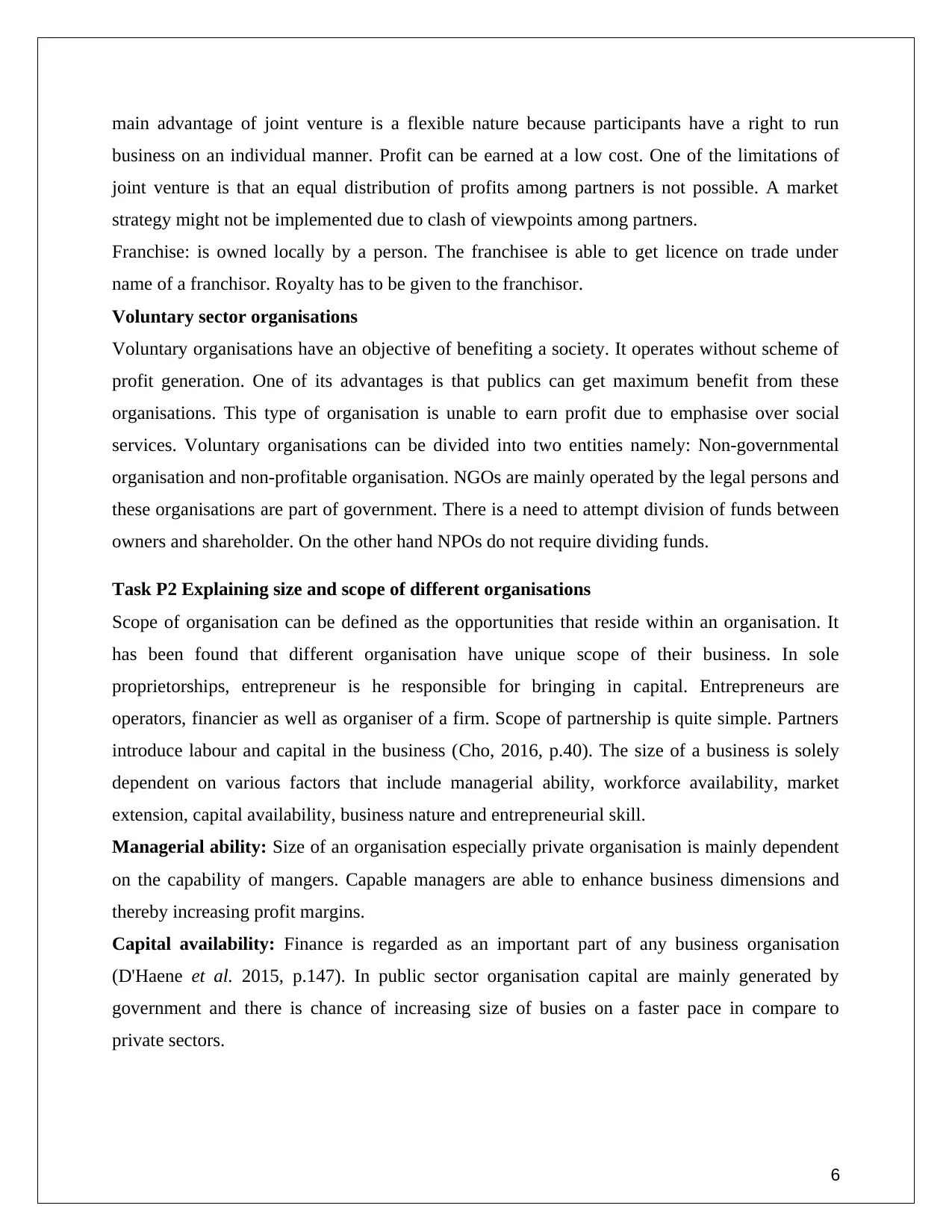
main advantage of joint venture is a flexible nature because participants have a right to run
business on an individual manner. Profit can be earned at a low cost. One of the limitations of
joint venture is that an equal distribution of profits among partners is not possible. A market
strategy might not be implemented due to clash of viewpoints among partners.
Franchise: is owned locally by a person. The franchisee is able to get licence on trade under
name of a franchisor. Royalty has to be given to the franchisor.
Voluntary sector organisations
Voluntary organisations have an objective of benefiting a society. It operates without scheme of
profit generation. One of its advantages is that publics can get maximum benefit from these
organisations. This type of organisation is unable to earn profit due to emphasise over social
services. Voluntary organisations can be divided into two entities namely: Non-governmental
organisation and non-profitable organisation. NGOs are mainly operated by the legal persons and
these organisations are part of government. There is a need to attempt division of funds between
owners and shareholder. On the other hand NPOs do not require dividing funds.
Task P2 Explaining size and scope of different organisations
Scope of organisation can be defined as the opportunities that reside within an organisation. It
has been found that different organisation have unique scope of their business. In sole
proprietorships, entrepreneur is he responsible for bringing in capital. Entrepreneurs are
operators, financier as well as organiser of a firm. Scope of partnership is quite simple. Partners
introduce labour and capital in the business (Cho, 2016, p.40). The size of a business is solely
dependent on various factors that include managerial ability, workforce availability, market
extension, capital availability, business nature and entrepreneurial skill.
Managerial ability: Size of an organisation especially private organisation is mainly dependent
on the capability of mangers. Capable managers are able to enhance business dimensions and
thereby increasing profit margins.
Capital availability: Finance is regarded as an important part of any business organisation
(D'Haene et al. 2015, p.147). In public sector organisation capital are mainly generated by
government and there is chance of increasing size of busies on a faster pace in compare to
private sectors.
6
business on an individual manner. Profit can be earned at a low cost. One of the limitations of
joint venture is that an equal distribution of profits among partners is not possible. A market
strategy might not be implemented due to clash of viewpoints among partners.
Franchise: is owned locally by a person. The franchisee is able to get licence on trade under
name of a franchisor. Royalty has to be given to the franchisor.
Voluntary sector organisations
Voluntary organisations have an objective of benefiting a society. It operates without scheme of
profit generation. One of its advantages is that publics can get maximum benefit from these
organisations. This type of organisation is unable to earn profit due to emphasise over social
services. Voluntary organisations can be divided into two entities namely: Non-governmental
organisation and non-profitable organisation. NGOs are mainly operated by the legal persons and
these organisations are part of government. There is a need to attempt division of funds between
owners and shareholder. On the other hand NPOs do not require dividing funds.
Task P2 Explaining size and scope of different organisations
Scope of organisation can be defined as the opportunities that reside within an organisation. It
has been found that different organisation have unique scope of their business. In sole
proprietorships, entrepreneur is he responsible for bringing in capital. Entrepreneurs are
operators, financier as well as organiser of a firm. Scope of partnership is quite simple. Partners
introduce labour and capital in the business (Cho, 2016, p.40). The size of a business is solely
dependent on various factors that include managerial ability, workforce availability, market
extension, capital availability, business nature and entrepreneurial skill.
Managerial ability: Size of an organisation especially private organisation is mainly dependent
on the capability of mangers. Capable managers are able to enhance business dimensions and
thereby increasing profit margins.
Capital availability: Finance is regarded as an important part of any business organisation
(D'Haene et al. 2015, p.147). In public sector organisation capital are mainly generated by
government and there is chance of increasing size of busies on a faster pace in compare to
private sectors.
6
⊘ This is a preview!⊘
Do you want full access?
Subscribe today to unlock all pages.

Trusted by 1+ million students worldwide
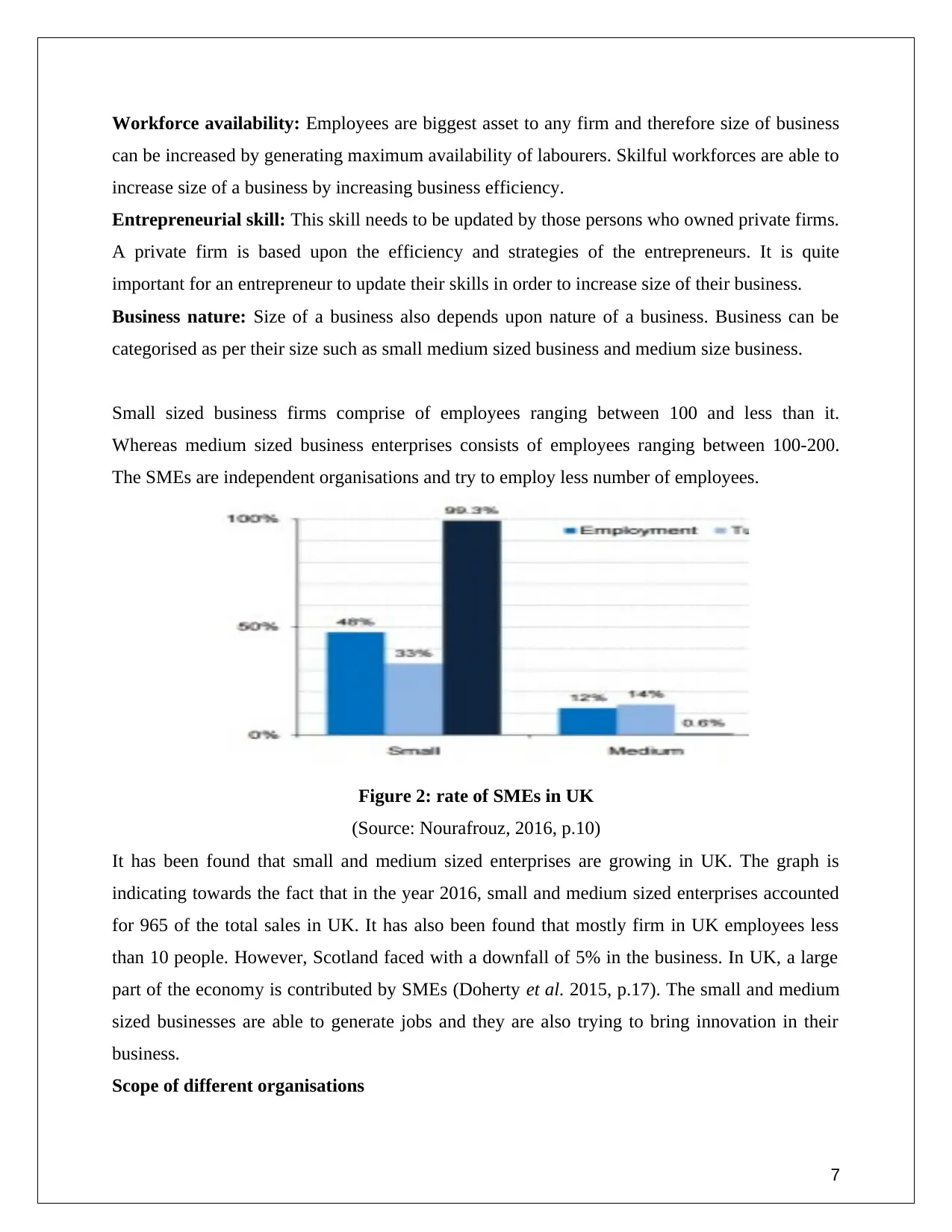
Workforce availability: Employees are biggest asset to any firm and therefore size of business
can be increased by generating maximum availability of labourers. Skilful workforces are able to
increase size of a business by increasing business efficiency.
Entrepreneurial skill: This skill needs to be updated by those persons who owned private firms.
A private firm is based upon the efficiency and strategies of the entrepreneurs. It is quite
important for an entrepreneur to update their skills in order to increase size of their business.
Business nature: Size of a business also depends upon nature of a business. Business can be
categorised as per their size such as small medium sized business and medium size business.
Small sized business firms comprise of employees ranging between 100 and less than it.
Whereas medium sized business enterprises consists of employees ranging between 100-200.
The SMEs are independent organisations and try to employ less number of employees.
Figure 2: rate of SMEs in UK
(Source: Nourafrouz, 2016, p.10)
It has been found that small and medium sized enterprises are growing in UK. The graph is
indicating towards the fact that in the year 2016, small and medium sized enterprises accounted
for 965 of the total sales in UK. It has also been found that mostly firm in UK employees less
than 10 people. However, Scotland faced with a downfall of 5% in the business. In UK, a large
part of the economy is contributed by SMEs (Doherty et al. 2015, p.17). The small and medium
sized businesses are able to generate jobs and they are also trying to bring innovation in their
business.
Scope of different organisations
7
can be increased by generating maximum availability of labourers. Skilful workforces are able to
increase size of a business by increasing business efficiency.
Entrepreneurial skill: This skill needs to be updated by those persons who owned private firms.
A private firm is based upon the efficiency and strategies of the entrepreneurs. It is quite
important for an entrepreneur to update their skills in order to increase size of their business.
Business nature: Size of a business also depends upon nature of a business. Business can be
categorised as per their size such as small medium sized business and medium size business.
Small sized business firms comprise of employees ranging between 100 and less than it.
Whereas medium sized business enterprises consists of employees ranging between 100-200.
The SMEs are independent organisations and try to employ less number of employees.
Figure 2: rate of SMEs in UK
(Source: Nourafrouz, 2016, p.10)
It has been found that small and medium sized enterprises are growing in UK. The graph is
indicating towards the fact that in the year 2016, small and medium sized enterprises accounted
for 965 of the total sales in UK. It has also been found that mostly firm in UK employees less
than 10 people. However, Scotland faced with a downfall of 5% in the business. In UK, a large
part of the economy is contributed by SMEs (Doherty et al. 2015, p.17). The small and medium
sized businesses are able to generate jobs and they are also trying to bring innovation in their
business.
Scope of different organisations
7
Paraphrase This Document
Need a fresh take? Get an instant paraphrase of this document with our AI Paraphraser
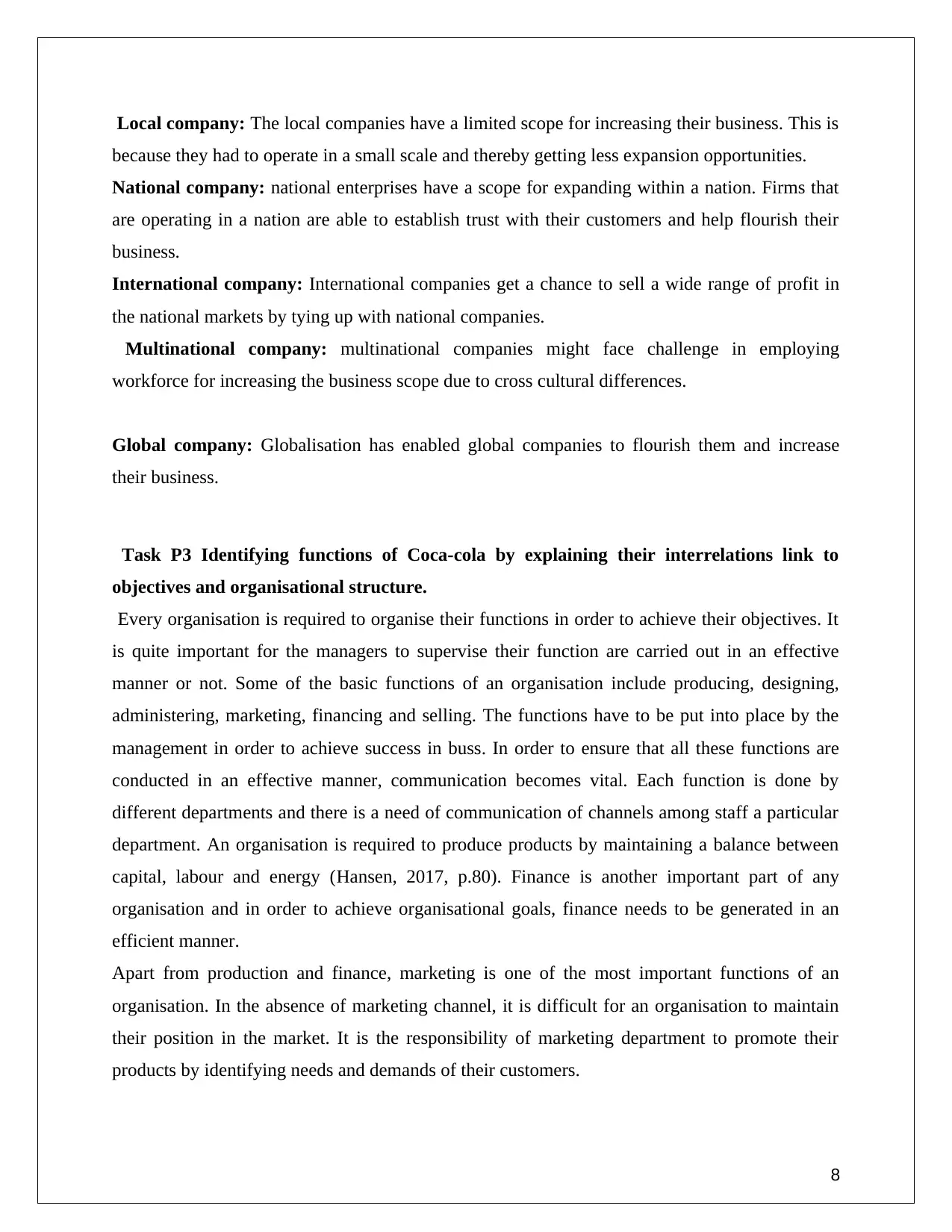
Local company: The local companies have a limited scope for increasing their business. This is
because they had to operate in a small scale and thereby getting less expansion opportunities.
National company: national enterprises have a scope for expanding within a nation. Firms that
are operating in a nation are able to establish trust with their customers and help flourish their
business.
International company: International companies get a chance to sell a wide range of profit in
the national markets by tying up with national companies.
Multinational company: multinational companies might face challenge in employing
workforce for increasing the business scope due to cross cultural differences.
Global company: Globalisation has enabled global companies to flourish them and increase
their business.
Task P3 Identifying functions of Coca-cola by explaining their interrelations link to
objectives and organisational structure.
Every organisation is required to organise their functions in order to achieve their objectives. It
is quite important for the managers to supervise their function are carried out in an effective
manner or not. Some of the basic functions of an organisation include producing, designing,
administering, marketing, financing and selling. The functions have to be put into place by the
management in order to achieve success in buss. In order to ensure that all these functions are
conducted in an effective manner, communication becomes vital. Each function is done by
different departments and there is a need of communication of channels among staff a particular
department. An organisation is required to produce products by maintaining a balance between
capital, labour and energy (Hansen, 2017, p.80). Finance is another important part of any
organisation and in order to achieve organisational goals, finance needs to be generated in an
efficient manner.
Apart from production and finance, marketing is one of the most important functions of an
organisation. In the absence of marketing channel, it is difficult for an organisation to maintain
their position in the market. It is the responsibility of marketing department to promote their
products by identifying needs and demands of their customers.
8
because they had to operate in a small scale and thereby getting less expansion opportunities.
National company: national enterprises have a scope for expanding within a nation. Firms that
are operating in a nation are able to establish trust with their customers and help flourish their
business.
International company: International companies get a chance to sell a wide range of profit in
the national markets by tying up with national companies.
Multinational company: multinational companies might face challenge in employing
workforce for increasing the business scope due to cross cultural differences.
Global company: Globalisation has enabled global companies to flourish them and increase
their business.
Task P3 Identifying functions of Coca-cola by explaining their interrelations link to
objectives and organisational structure.
Every organisation is required to organise their functions in order to achieve their objectives. It
is quite important for the managers to supervise their function are carried out in an effective
manner or not. Some of the basic functions of an organisation include producing, designing,
administering, marketing, financing and selling. The functions have to be put into place by the
management in order to achieve success in buss. In order to ensure that all these functions are
conducted in an effective manner, communication becomes vital. Each function is done by
different departments and there is a need of communication of channels among staff a particular
department. An organisation is required to produce products by maintaining a balance between
capital, labour and energy (Hansen, 2017, p.80). Finance is another important part of any
organisation and in order to achieve organisational goals, finance needs to be generated in an
efficient manner.
Apart from production and finance, marketing is one of the most important functions of an
organisation. In the absence of marketing channel, it is difficult for an organisation to maintain
their position in the market. It is the responsibility of marketing department to promote their
products by identifying needs and demands of their customers.
8
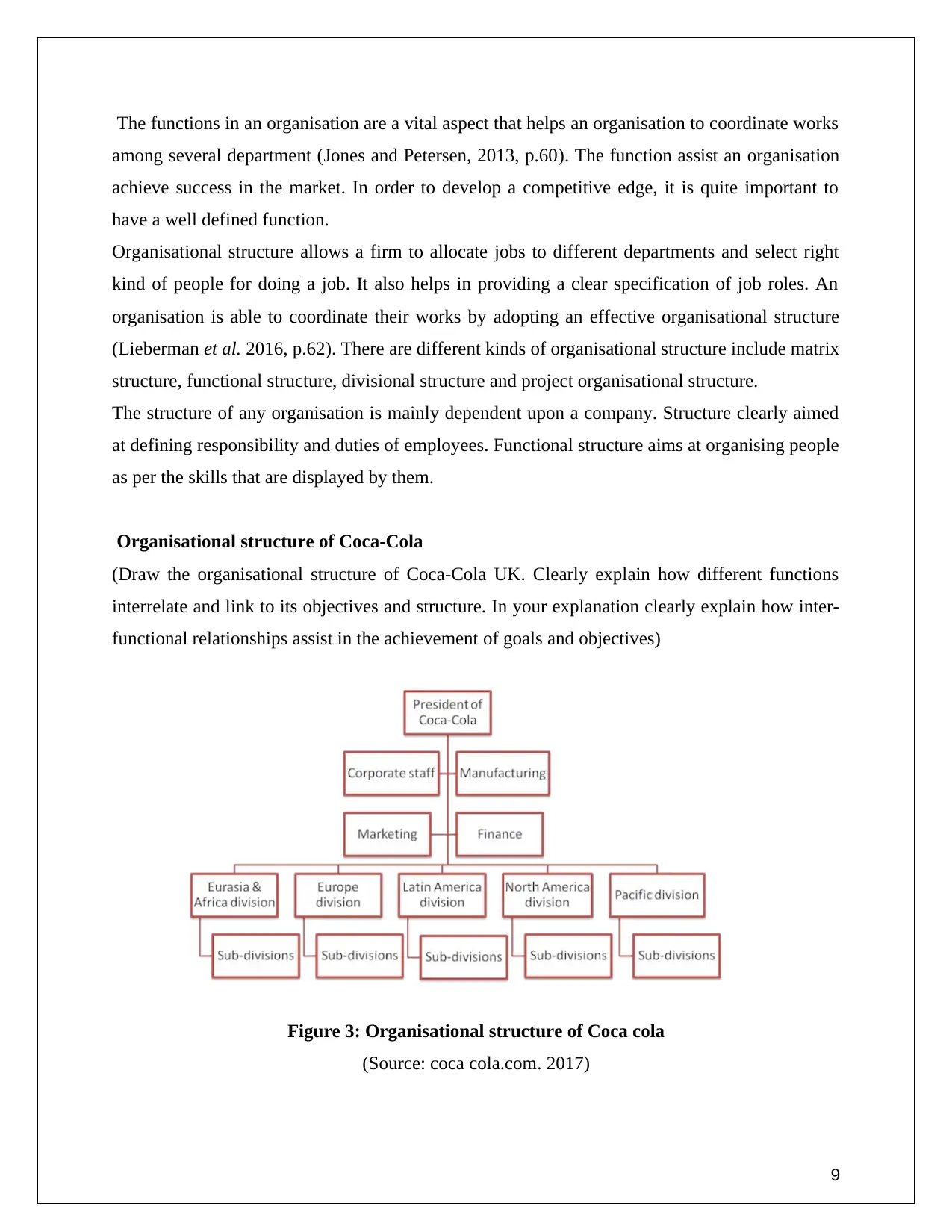
The functions in an organisation are a vital aspect that helps an organisation to coordinate works
among several department (Jones and Petersen, 2013, p.60). The function assist an organisation
achieve success in the market. In order to develop a competitive edge, it is quite important to
have a well defined function.
Organisational structure allows a firm to allocate jobs to different departments and select right
kind of people for doing a job. It also helps in providing a clear specification of job roles. An
organisation is able to coordinate their works by adopting an effective organisational structure
(Lieberman et al. 2016, p.62). There are different kinds of organisational structure include matrix
structure, functional structure, divisional structure and project organisational structure.
The structure of any organisation is mainly dependent upon a company. Structure clearly aimed
at defining responsibility and duties of employees. Functional structure aims at organising people
as per the skills that are displayed by them.
Organisational structure of Coca-Cola
(Draw the organisational structure of Coca-Cola UK. Clearly explain how different functions
interrelate and link to its objectives and structure. In your explanation clearly explain how inter-
functional relationships assist in the achievement of goals and objectives)
Figure 3: Organisational structure of Coca cola
(Source: coca cola.com. 2017)
9
among several department (Jones and Petersen, 2013, p.60). The function assist an organisation
achieve success in the market. In order to develop a competitive edge, it is quite important to
have a well defined function.
Organisational structure allows a firm to allocate jobs to different departments and select right
kind of people for doing a job. It also helps in providing a clear specification of job roles. An
organisation is able to coordinate their works by adopting an effective organisational structure
(Lieberman et al. 2016, p.62). There are different kinds of organisational structure include matrix
structure, functional structure, divisional structure and project organisational structure.
The structure of any organisation is mainly dependent upon a company. Structure clearly aimed
at defining responsibility and duties of employees. Functional structure aims at organising people
as per the skills that are displayed by them.
Organisational structure of Coca-Cola
(Draw the organisational structure of Coca-Cola UK. Clearly explain how different functions
interrelate and link to its objectives and structure. In your explanation clearly explain how inter-
functional relationships assist in the achievement of goals and objectives)
Figure 3: Organisational structure of Coca cola
(Source: coca cola.com. 2017)
9
⊘ This is a preview!⊘
Do you want full access?
Subscribe today to unlock all pages.

Trusted by 1+ million students worldwide
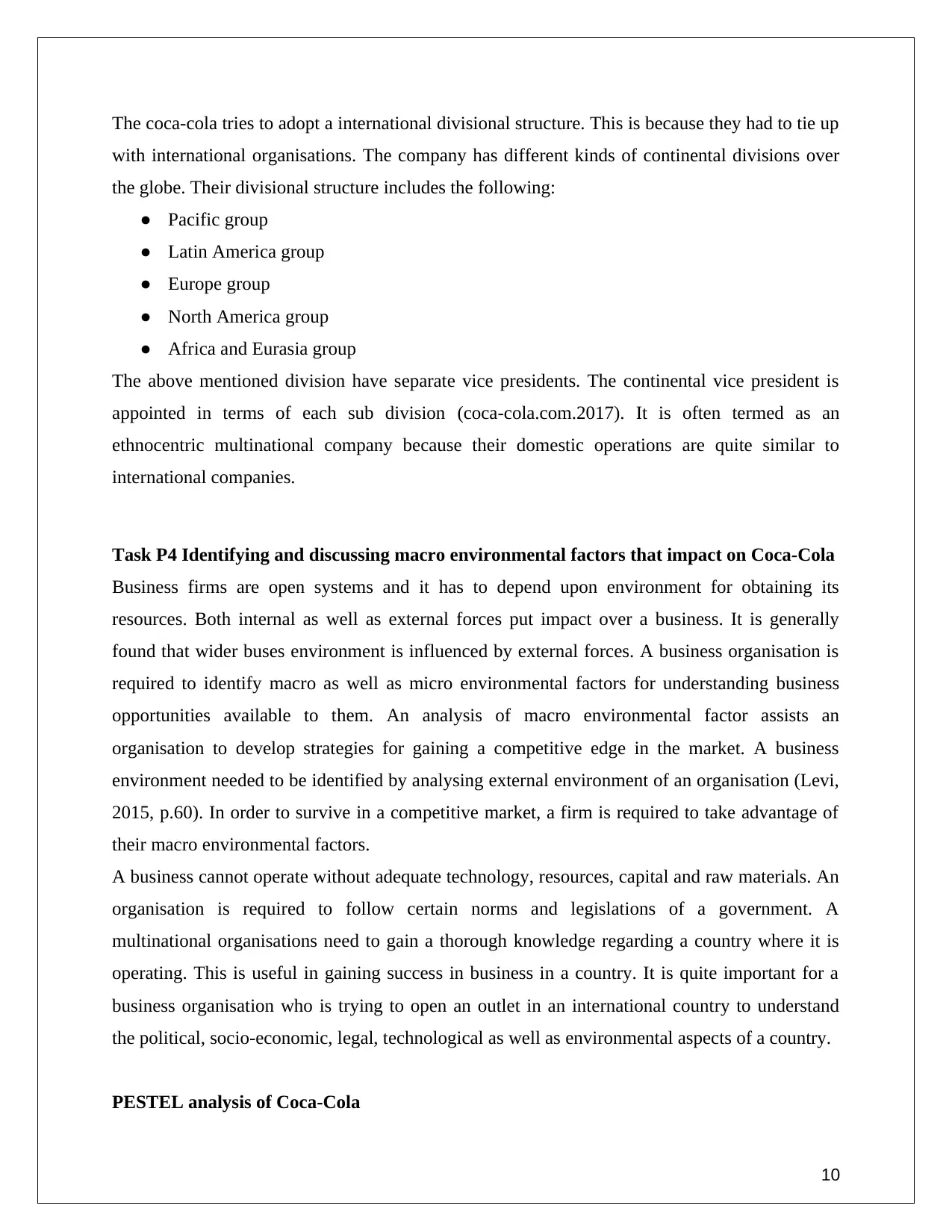
The coca-cola tries to adopt a international divisional structure. This is because they had to tie up
with international organisations. The company has different kinds of continental divisions over
the globe. Their divisional structure includes the following:
● Pacific group
● Latin America group
● Europe group
● North America group
● Africa and Eurasia group
The above mentioned division have separate vice presidents. The continental vice president is
appointed in terms of each sub division (coca-cola.com.2017). It is often termed as an
ethnocentric multinational company because their domestic operations are quite similar to
international companies.
Task P4 Identifying and discussing macro environmental factors that impact on Coca-Cola
Business firms are open systems and it has to depend upon environment for obtaining its
resources. Both internal as well as external forces put impact over a business. It is generally
found that wider buses environment is influenced by external forces. A business organisation is
required to identify macro as well as micro environmental factors for understanding business
opportunities available to them. An analysis of macro environmental factor assists an
organisation to develop strategies for gaining a competitive edge in the market. A business
environment needed to be identified by analysing external environment of an organisation (Levi,
2015, p.60). In order to survive in a competitive market, a firm is required to take advantage of
their macro environmental factors.
A business cannot operate without adequate technology, resources, capital and raw materials. An
organisation is required to follow certain norms and legislations of a government. A
multinational organisations need to gain a thorough knowledge regarding a country where it is
operating. This is useful in gaining success in business in a country. It is quite important for a
business organisation who is trying to open an outlet in an international country to understand
the political, socio-economic, legal, technological as well as environmental aspects of a country.
PESTEL analysis of Coca-Cola
10
with international organisations. The company has different kinds of continental divisions over
the globe. Their divisional structure includes the following:
● Pacific group
● Latin America group
● Europe group
● North America group
● Africa and Eurasia group
The above mentioned division have separate vice presidents. The continental vice president is
appointed in terms of each sub division (coca-cola.com.2017). It is often termed as an
ethnocentric multinational company because their domestic operations are quite similar to
international companies.
Task P4 Identifying and discussing macro environmental factors that impact on Coca-Cola
Business firms are open systems and it has to depend upon environment for obtaining its
resources. Both internal as well as external forces put impact over a business. It is generally
found that wider buses environment is influenced by external forces. A business organisation is
required to identify macro as well as micro environmental factors for understanding business
opportunities available to them. An analysis of macro environmental factor assists an
organisation to develop strategies for gaining a competitive edge in the market. A business
environment needed to be identified by analysing external environment of an organisation (Levi,
2015, p.60). In order to survive in a competitive market, a firm is required to take advantage of
their macro environmental factors.
A business cannot operate without adequate technology, resources, capital and raw materials. An
organisation is required to follow certain norms and legislations of a government. A
multinational organisations need to gain a thorough knowledge regarding a country where it is
operating. This is useful in gaining success in business in a country. It is quite important for a
business organisation who is trying to open an outlet in an international country to understand
the political, socio-economic, legal, technological as well as environmental aspects of a country.
PESTEL analysis of Coca-Cola
10
Paraphrase This Document
Need a fresh take? Get an instant paraphrase of this document with our AI Paraphraser
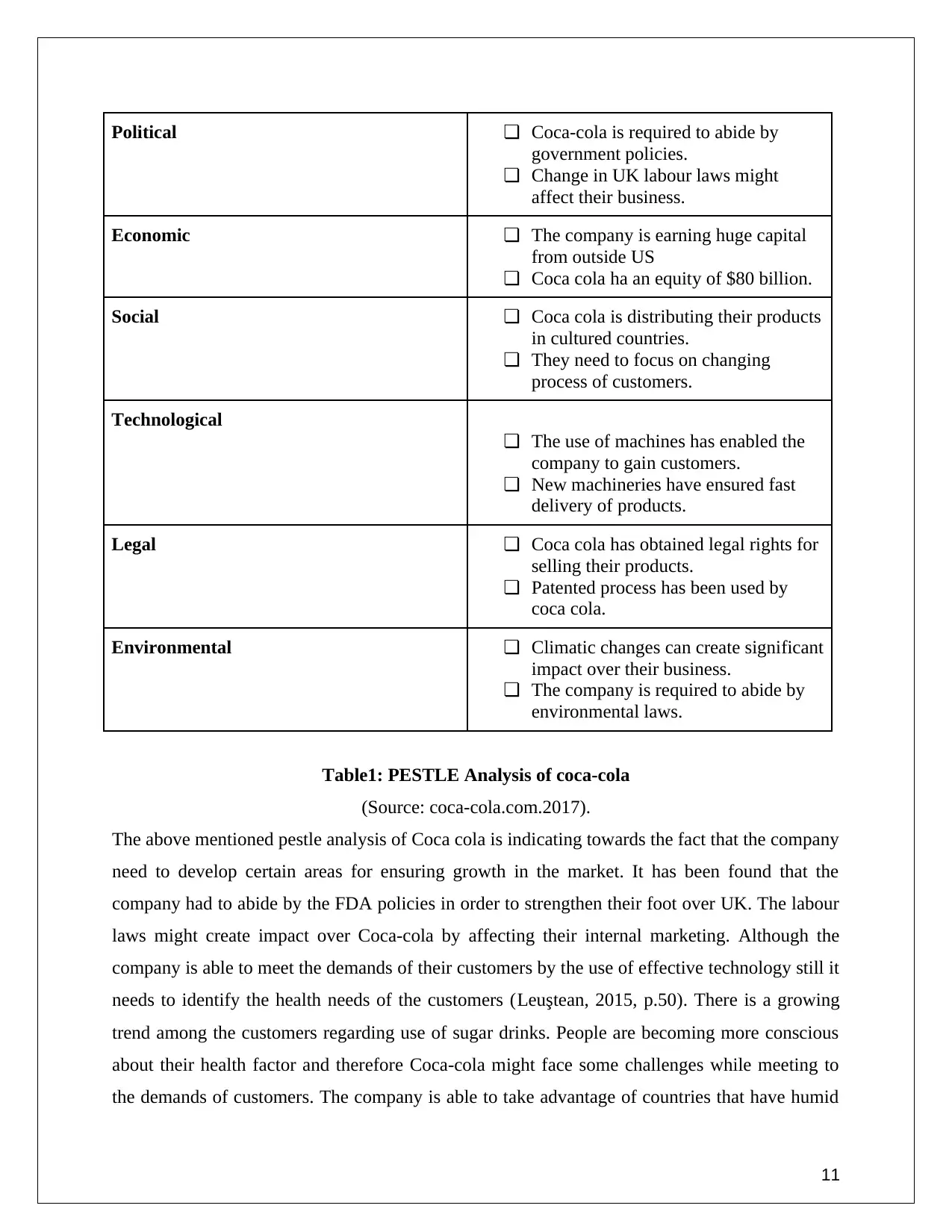
Political ❏ Coca-cola is required to abide by
government policies.
❏ Change in UK labour laws might
affect their business.
Economic ❏ The company is earning huge capital
from outside US
❏ Coca cola ha an equity of $80 billion.
Social ❏ Coca cola is distributing their products
in cultured countries.
❏ They need to focus on changing
process of customers.
Technological
❏ The use of machines has enabled the
company to gain customers.
❏ New machineries have ensured fast
delivery of products.
Legal ❏ Coca cola has obtained legal rights for
selling their products.
❏ Patented process has been used by
coca cola.
Environmental ❏ Climatic changes can create significant
impact over their business.
❏ The company is required to abide by
environmental laws.
Table1: PESTLE Analysis of coca-cola
(Source: coca-cola.com.2017).
The above mentioned pestle analysis of Coca cola is indicating towards the fact that the company
need to develop certain areas for ensuring growth in the market. It has been found that the
company had to abide by the FDA policies in order to strengthen their foot over UK. The labour
laws might create impact over Coca-cola by affecting their internal marketing. Although the
company is able to meet the demands of their customers by the use of effective technology still it
needs to identify the health needs of the customers (Leuştean, 2015, p.50). There is a growing
trend among the customers regarding use of sugar drinks. People are becoming more conscious
about their health factor and therefore Coca-cola might face some challenges while meeting to
the demands of customers. The company is able to take advantage of countries that have humid
11
government policies.
❏ Change in UK labour laws might
affect their business.
Economic ❏ The company is earning huge capital
from outside US
❏ Coca cola ha an equity of $80 billion.
Social ❏ Coca cola is distributing their products
in cultured countries.
❏ They need to focus on changing
process of customers.
Technological
❏ The use of machines has enabled the
company to gain customers.
❏ New machineries have ensured fast
delivery of products.
Legal ❏ Coca cola has obtained legal rights for
selling their products.
❏ Patented process has been used by
coca cola.
Environmental ❏ Climatic changes can create significant
impact over their business.
❏ The company is required to abide by
environmental laws.
Table1: PESTLE Analysis of coca-cola
(Source: coca-cola.com.2017).
The above mentioned pestle analysis of Coca cola is indicating towards the fact that the company
need to develop certain areas for ensuring growth in the market. It has been found that the
company had to abide by the FDA policies in order to strengthen their foot over UK. The labour
laws might create impact over Coca-cola by affecting their internal marketing. Although the
company is able to meet the demands of their customers by the use of effective technology still it
needs to identify the health needs of the customers (Leuştean, 2015, p.50). There is a growing
trend among the customers regarding use of sugar drinks. People are becoming more conscious
about their health factor and therefore Coca-cola might face some challenges while meeting to
the demands of customers. The company is able to take advantage of countries that have humid
11
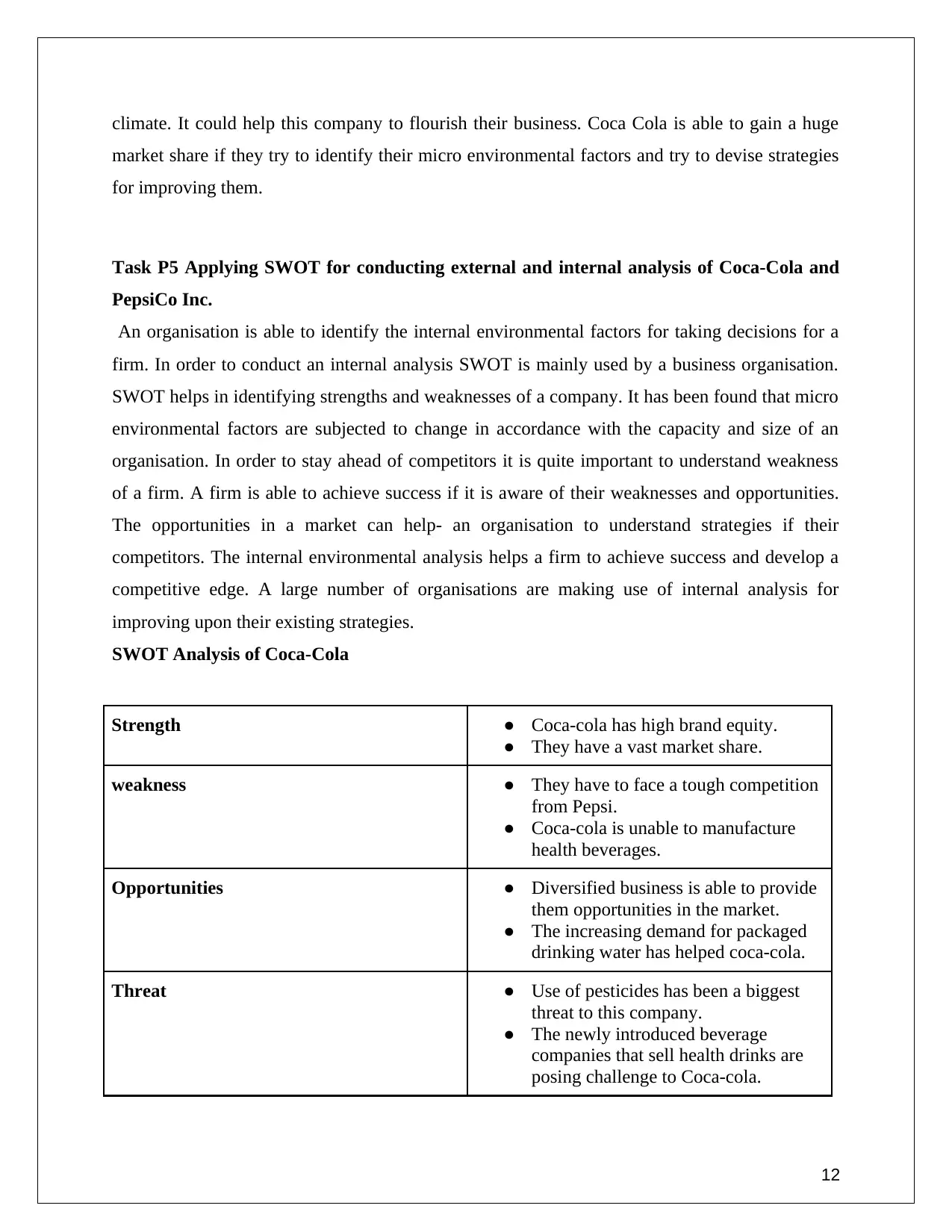
climate. It could help this company to flourish their business. Coca Cola is able to gain a huge
market share if they try to identify their micro environmental factors and try to devise strategies
for improving them.
Task P5 Applying SWOT for conducting external and internal analysis of Coca-Cola and
PepsiCo Inc.
An organisation is able to identify the internal environmental factors for taking decisions for a
firm. In order to conduct an internal analysis SWOT is mainly used by a business organisation.
SWOT helps in identifying strengths and weaknesses of a company. It has been found that micro
environmental factors are subjected to change in accordance with the capacity and size of an
organisation. In order to stay ahead of competitors it is quite important to understand weakness
of a firm. A firm is able to achieve success if it is aware of their weaknesses and opportunities.
The opportunities in a market can help- an organisation to understand strategies if their
competitors. The internal environmental analysis helps a firm to achieve success and develop a
competitive edge. A large number of organisations are making use of internal analysis for
improving upon their existing strategies.
SWOT Analysis of Coca-Cola
Strength ● Coca-cola has high brand equity.
● They have a vast market share.
weakness ● They have to face a tough competition
from Pepsi.
● Coca-cola is unable to manufacture
health beverages.
Opportunities ● Diversified business is able to provide
them opportunities in the market.
● The increasing demand for packaged
drinking water has helped coca-cola.
Threat ● Use of pesticides has been a biggest
threat to this company.
● The newly introduced beverage
companies that sell health drinks are
posing challenge to Coca-cola.
12
market share if they try to identify their micro environmental factors and try to devise strategies
for improving them.
Task P5 Applying SWOT for conducting external and internal analysis of Coca-Cola and
PepsiCo Inc.
An organisation is able to identify the internal environmental factors for taking decisions for a
firm. In order to conduct an internal analysis SWOT is mainly used by a business organisation.
SWOT helps in identifying strengths and weaknesses of a company. It has been found that micro
environmental factors are subjected to change in accordance with the capacity and size of an
organisation. In order to stay ahead of competitors it is quite important to understand weakness
of a firm. A firm is able to achieve success if it is aware of their weaknesses and opportunities.
The opportunities in a market can help- an organisation to understand strategies if their
competitors. The internal environmental analysis helps a firm to achieve success and develop a
competitive edge. A large number of organisations are making use of internal analysis for
improving upon their existing strategies.
SWOT Analysis of Coca-Cola
Strength ● Coca-cola has high brand equity.
● They have a vast market share.
weakness ● They have to face a tough competition
from Pepsi.
● Coca-cola is unable to manufacture
health beverages.
Opportunities ● Diversified business is able to provide
them opportunities in the market.
● The increasing demand for packaged
drinking water has helped coca-cola.
Threat ● Use of pesticides has been a biggest
threat to this company.
● The newly introduced beverage
companies that sell health drinks are
posing challenge to Coca-cola.
12
⊘ This is a preview!⊘
Do you want full access?
Subscribe today to unlock all pages.

Trusted by 1+ million students worldwide
1 out of 18
Related Documents
Your All-in-One AI-Powered Toolkit for Academic Success.
+13062052269
info@desklib.com
Available 24*7 on WhatsApp / Email
![[object Object]](/_next/static/media/star-bottom.7253800d.svg)
Unlock your academic potential
Copyright © 2020–2025 A2Z Services. All Rights Reserved. Developed and managed by ZUCOL.





